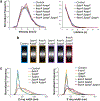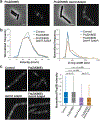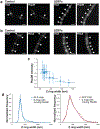Single-molecule imaging reveals that Z-ring condensation is essential for cell division in Bacillus subtilis
- PMID: 33737746
- PMCID: PMC8085161
- DOI: 10.1038/s41564-021-00878-z
Single-molecule imaging reveals that Z-ring condensation is essential for cell division in Bacillus subtilis
Abstract
Although many components of the cell division machinery in bacteria have been identified1,2, the mechanisms by which they work together to divide the cell remain poorly understood. Key among these components is the tubulin FtsZ, which forms a Z ring at the midcell. FtsZ recruits the other cell division proteins, collectively called the divisome, and the Z ring constricts as the cell divides. We applied live-cell single-molecule imaging to describe the dynamics of the divisome in detail, and to evaluate the individual roles of FtsZ-binding proteins (ZBPs), specifically FtsA and the ZBPs EzrA, SepF and ZapA, in cytokinesis. We show that the divisome comprises two subcomplexes that move differently: stationary ZBPs that transiently bind to treadmilling FtsZ filaments, and a moving complex that includes cell wall synthases. Our imaging analyses reveal that ZBPs bundle FtsZ filaments together and condense them into Z rings, and that this condensation is necessary for cytokinesis.
Conflict of interest statement
Figures














Comment in
-
Keeping division on track.Nat Microbiol. 2021 May;6(5):538-539. doi: 10.1038/s41564-021-00891-2. Nat Microbiol. 2021. PMID: 33927383 No abstract available.
Similar articles
-
Minimization of the Bacillus subtilis divisome suggests FtsZ and SepF can form an active Z-ring, and reveals the amino acid transporter BraB as a new cell division influencing factor.PLoS Genet. 2025 Jan 27;21(1):e1011567. doi: 10.1371/journal.pgen.1011567. eCollection 2025 Jan. PLoS Genet. 2025. PMID: 39869651 Free PMC article.
-
Structure and function of a spectrin-like regulator of bacterial cytokinesis.Nat Commun. 2014 Nov 18;5:5421. doi: 10.1038/ncomms6421. Nat Commun. 2014. PMID: 25403286 Free PMC article.
-
Structural and genetic analyses reveal the protein SepF as a new membrane anchor for the Z ring.Proc Natl Acad Sci U S A. 2013 Nov 26;110(48):E4601-10. doi: 10.1073/pnas.1313978110. Epub 2013 Nov 11. Proc Natl Acad Sci U S A. 2013. PMID: 24218584 Free PMC article.
-
Regulation of cytokinesis: FtsZ and its accessory proteins.Curr Genet. 2020 Feb;66(1):43-49. doi: 10.1007/s00294-019-01005-6. Epub 2019 Jun 17. Curr Genet. 2020. PMID: 31209564 Review.
-
At the Heart of Bacterial Cytokinesis: The Z Ring.Trends Microbiol. 2019 Sep;27(9):781-791. doi: 10.1016/j.tim.2019.04.011. Epub 2019 Jun 3. Trends Microbiol. 2019. PMID: 31171437 Free PMC article. Review.
Cited by
-
Insights into the assembly and regulation of the bacterial divisome.Nat Rev Microbiol. 2024 Jan;22(1):33-45. doi: 10.1038/s41579-023-00942-x. Epub 2023 Jul 31. Nat Rev Microbiol. 2024. PMID: 37524757 Free PMC article. Review.
-
Elongation at Midcell in Preparation of Cell Division Requires FtsZ, but Not MreB nor PBP2 in Caulobacter crescentus.Front Microbiol. 2021 Aug 27;12:732031. doi: 10.3389/fmicb.2021.732031. eCollection 2021. Front Microbiol. 2021. PMID: 34512611 Free PMC article.
-
A Novel Z-Ring Associated Protein ZapA-Like Protein (PA5407) From Pseudomonas aeruginosa Promotes FtsZ to Form Double Filaments.Front Microbiol. 2021 Aug 4;12:717013. doi: 10.3389/fmicb.2021.717013. eCollection 2021. Front Microbiol. 2021. PMID: 34421877 Free PMC article.
-
Engineered Cell Elongation Promotes Extracellular Electron Transfer of Shewanella Oneidensis.Adv Sci (Weinh). 2024 Nov;11(41):e2403067. doi: 10.1002/advs.202403067. Epub 2024 Sep 5. Adv Sci (Weinh). 2024. PMID: 39234800 Free PMC article.
-
EzrA promotes Z-ring formation through interaction of its QNR motif with FtsA.J Bacteriol. 2025 Jul 24;207(7):e0012525. doi: 10.1128/jb.00125-25. Epub 2025 Jul 3. J Bacteriol. 2025. PMID: 40608290 Free PMC article.
References
Publication types
MeSH terms
Substances
Grants and funding
LinkOut - more resources
Full Text Sources
Other Literature Sources
Molecular Biology Databases

